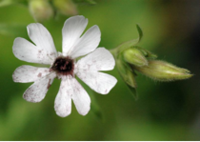
FungiSex

Silene latifolia infected by Microbotryum (Photo M. Hood)
Evolution of mating types and sex chromosomes in fungi
Evolution of anisogamy and of the number of mating types
In most multicellular eukaryotes, haploid fusion during sexual reproduction is between specialised sex cells known as gametes. A variety of developmental and genetic mechanisms exist that determine which gametes are capable of fusing to produce the zygotic stage. Anisogamy, the condition of size dimorphic gametes, is thought to be derived from isogamy, but is ancient and widespread. Individuals of anisogamous species may produce a single type of gamete, as in species with separate sexes (i.e. gonochorous animals or dioecious plants), or both types of gametes, as in hermaphrodite species. In gonochorous or dioecious species (all vertebrates and arthropods, some nematodes, molluscs, plants) diploid individuals can only mate with other individuals producing the alternate gamete type.
Evolution of sex chromosomes
Once mating types or separate sexes have appeared, recombination is often subsequently suppressed around the sex- or the mating type-determining genes, sometimes leading to sex chromosomes when the suppression operates on the majority of the chromosome. The most frequently posited theory for recombination suppression on sex chromosomes is selection for linkage around the sex-determining genes of several other genes that are relatively more beneficial in one sex than the other (Rice, 1987; Charlesworth et al., 2005). In several plants and animals, "evolutionary strata" have been found on the sex chromosomes, representing stages in the expansion of recombination suppression, starting from the essential sex determining region and eventually encompassing most of the sex chromosome length
The aim of this project is therefore to use Microbotryum species as models to study these related fundamental aspects on the evolution of mating types, sexes, and sex chromosomes.
Duration: 01/09/2009 to 31/08/2012
Coordinator: Tatiana Giraud
- Université Paris-Sud, Laboratoire d'Ecologie, Systématique et Evolution, Orsay, France (Tatiana Giraud)
- INRA UR1164 URGI, Versailles, France (Joelle Amselem)
Project funded by ANR-Blanc
Creation date: 27 Apr 2010
 eZ Publish
eZ PublishPublication supervisor: A-F. Adam-Blondon
Read Credits & General Terms of Use
Read How to cite









